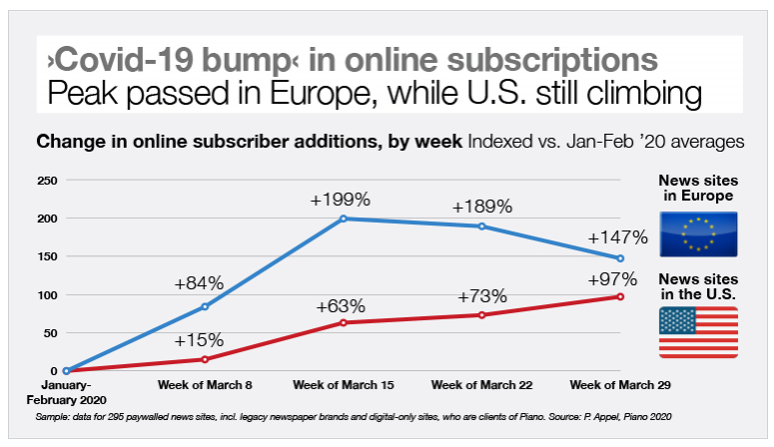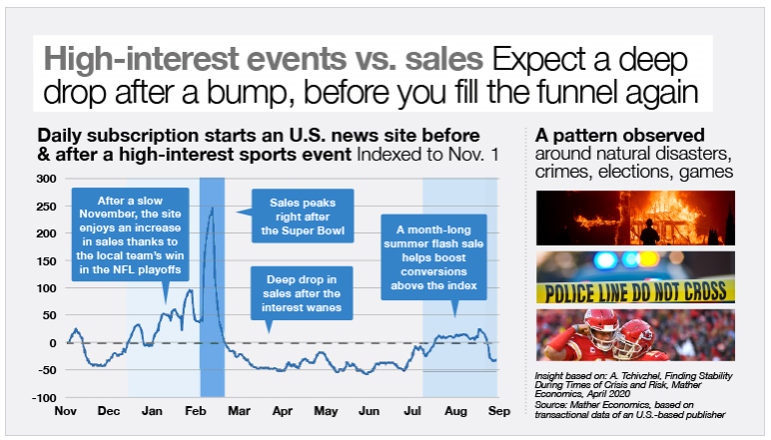Reader Revenue Blog
INMA
7 April 2020
By Grzegorz Piechota
As countries throughout the world move through different phases along the COVID-19 trajectory, so does the bump news media companies are getting from huge increases in digital subscriptions. Research from previous bumps indicates the increases will not last.
The peak of “COVID-19 bump” in subscriptions has passed in Europe, while subscriptions in the United States are still climbing. Sales of online subscriptions to U.S. news are now up 97% compared to the pre-crisis period. That’s up from 73% the week before.

The growth of the European sites, both legacy and digital-only brands, peaked in mid-March and last week it continued to slow down from 189% to 147% up vs. the January-February averages.
These benchmarks are based on the transactional data of 295 paywalled news sites across the world, a courtesy of Piano, a digital business platform vendor.
News publishers should expect a deep drop in new subscription sales, even below the pre-COVID averages, suggests an analysis of the previous sales bumps by Mather Economics, a business consultancy.
“During and after high-interest news events such as natural disasters, elections, crimes, or dramatic sports events, we observed a similar pattern in the subscription sales,” said Matt Lindsay, president of Mather Economics.
Here is what his data team saw over and over:
– The big news event attracted new readers to the news site (they filled the top of the purchase funnel), and it mobilised existing readers to visit more frequently and read more articles (the bottom of the funnel).
– Many of the latter readers — who otherwise might wait weeks or months to purchase a subscription — decided to buy sooner. This is what made the sales to spike temporarily.
– After converting those mobilised readers, the bottom of the funnel got empty. At the same time, the new readers were not engaged enough yet to purchase. And this is what made the sales to dive, after the bump was over.
“The high-interest news event speeds the acquisition, but that creates a gap in the bottom of the funnel,” explained Lindsay.

In a detailed analysis published online, Mather’s Senior Director of Product Development Arvid Tchivzhel presented a data set from an U.S. news site as an example for the “Hard Landing” pattern.
-The news site experienced a 250% increase in new subscriptions starts around the Super Bowl win for the local team. The Super Bowl is the annual championship game of the U.S. National Football League (NFL). It regularly scores record audiences on TV and other channels.
-The bump in subscriptions started after playoff wins and lasted for two months, with the culmination during the February finale — the Super Bowl.
-After the game the readers’ interest waned quickly and the news site saw a sudden drop in new subscription starts, even 50% below the pre-bump period.
-The slow sales period lasted five long months, or until the summer, when the news site boosted daily starts with a month-long summer flash sale.
The hypothesis of the Hard Landing by Mather Economics’ data team might be supported by another study, of user flows at an European publisher, that we covered last week. It showed the COVID-19 bump most likely came from the mobilisation of already engaged readers. The new ones attracted to the site for the first time might convert too, but not in the near term. They need to engage first with the site’s content, and that typically took weeks or months.
“An average subscriber converts after being stopped and exposed the offer seven times,” said Lindsay, who recommended publishers keep original journalism behind the paywall during a surge in demand and remove discounts. “You may reintroduce discounts right after the demand goes back to normal.”

